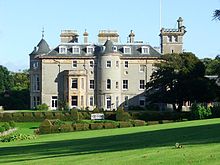Finlaystone House
Finlaystone House is a manor house near the Scottish town of Kilmacolm in Inverclyde . In 1971 the building was included in the Scottish List of Monuments in the highest category A. The property is isolated on the eastern border of Inverclyde and Renfrewshire between the parishes of Port Glasgow and Langbank on the south bank of the Firth of Clyde . Parts of the gardens are already part of Renfrewshire.
history
The lands of "Finlay's Town" were first mentioned in the 12th century. Around 1400 they came into the possession of the Cunningham clan through marriage . In this century, Finlaystone Castle was a fortified predecessor of the present manor house, which was the seat of the Earls of Glencairn until the line was extinct in 1796 . In 1746, William Cunningham, 13th Earl of Glencairn had the manor house built today. He hired John Douglas as an architect . It is likely that large parts of the old building were torn down, but that some fragments were also taken over into the new house. The poet Robert Burns later spent some time on the estate. During this time he scratched his name on a window frame, which has been preserved to this day.
After the line died out in 1796 with John Cunningham, 15th Earl of Glencairn , the property went to Robert Graham of Gartmore , who founded the line of the Cunninghame Grahams . His son, William Cunninghame Cunninghame Graham , lost a fortune after being convicted of counterfeiting money. At the age of eleven, Robert Cunninghame Graham was forced to sell Finlaystone House due to the financial situation in 1863. David Carrick-Buchanan bought the property, expanded it in 1872 and leased it to George J. Kidston from 1873 , who bought it 14 years later. Between 1898 and 1902 the building was expanded again. The important architect John James Burnet was won over for the work . By marriage, Findlaystone came in the first half of the 20th century into the possession of the Macmillan clan , whose clan seat it has been since then. The extensive parks are now open to the public, while parts of the house can be rented for celebrations.
Individual evidence
- ↑ Listed Building - Entry . In: Historic Scotland .
- ↑ a b history of the property
- ↑ a b Entry on Finlaystone House in Canmore, the database of Historic Environment Scotland (English)
Web links
- Internet presence of the property
- Entry on Finlaystone House in Canmore, Historic Environment Scotland database
Coordinates: 55 ° 55 ′ 43 " N , 4 ° 37 ′ 9" W
